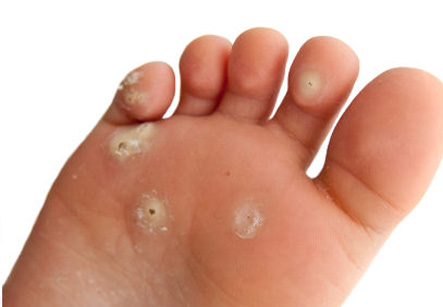Verrucae
Introduction
Verrucae also called as plantar warts are abnormal growths formed due to proliferation of superficial layers of skin which are found commonly over the pressure areas of the feet such as heel and ball of big toe. They are usually self-limiting but may be treated if cause discomfort or other complications.
Causative agent
Warts are caused by infection due to the human papillomavirus types 1 and 2 commonly but also can be caused by type 4. First, they affect the epithelial cells causing small rough papules. A proliferative reaction caused by the replication of the virus in the epithelial cells leads to formation of plaque or papule. Incubation period is variable, ranging from one month to about two years.
Incidence and spread
1. It affects women more than men.
2. It is more common in teenagers and children.
3. Warts have a tendency to occur in certain professions like butchers, abattoir workers, engineers and office workers.
We have all the information you need about public and private clinics and hospitals that provide Podiatry-Chiropody treatments in Iran, Islamic Republic Of with the best quality and lowest possible prices

4. Person to person spread occurs in warts.
5. Plantar warts are associated with communal showers.
6. Skin damage predisposes to warts.
7. Habits like scratching, nail-biting, and finger-sucking can encourage auto-inoculation of viral warts.
Symptoms
1. Pain during walking
2. Due to altered posture or gait disturbances, leg or back pain can occur.
3. They can affect more than one family member.
4. Warts are more common in:
• Certain occupations.
• Atopic eczema
• AIDS patients
• Long term steroids or immunosuppressant drugs
• Impaired cellular immunity
• Transplant recipients
• Patients having lymphomas and leukemia
Examination and diagnosis
1. Firm and hyperkeratotic lesions.
2. Found over pressure areas of feet.
3. They are flat because of pressure.
4. Formation of petechiae or pinpoint bleeding within the lesions.
5. May fuse with surrounding warts called as mosaic warts.
6. It should be carefully differentiated from other mimicking lesions of skin.
Diagnosis and tests
Diagnosis is made by the doctor or skin specialist by observation of typical features.
1. Common warts are usually found on the knuckles, knees and fingers. They are firm and raised with a roughened, cauliflower-like surface.
2. Plain warts are common on dorsal aspect of hands and are round, flat and yellow in colour.
3. Filiform warts- these are long and slender found on face and neck.
4. Plantar warts or verrucae are painful, have petechiae or pin point bleeding within them. They grow on the soles of the feet on pressure points.
5. Mosaic warts occur when palmar or plantar warts fuse with each other to form large plaques.
Tests
Warts are caused by infection due to the human papillomavirus types 1 and 2 commonly but also can be caused by type 4.
No tests are usually required or appropriate. Pairing of keratin may be required to distinguish them from corns. Blood tests to check for the cause of immunodeficiency may be required in abnormally widespread or resistant cases to treatment.
Management
The treatment options for verrucaes are given. But it should be decided by the doctor as which patients are candidates for the treatment. Natural history of the disease should be taken into account prior to treatment. Usually no treatment is required if verrucae don’t cause symptoms.
These patients are likely to require the treatment
1. Painful warts
2. In immunosuppressed patients.
3. In persistent cases present for more than two years.
4. Choice of the patient to get treated.
Choices of treatment are
1. Salicylic acid preparations:
Various formulations or application methods are available such as:
• Plasters
• Gel
• Paint
• Collodion
• As a combination with podophyllum resin.
2. Formaldehyde and glutaraldehyde preparations –they are used rarely because of unpleasant nature.
3. Cryotherapy – 2 to 4 treatment sessions are usually required after pairing the excess keratin using a 1-minute freeze/thaw cycle. Each session should be four weeks apart from each other.
4. Rare methods are surgical excision, curettage, 5-fluorouracil or bleomycin therapy, interferon, and photodynamic therapy.
5. Secondary referral is necessary for multiple verrucae in immune-compromisedand diabetic patients.
Complications
1. Excessive pain
2. Infection
3. Scar or keloid formation after the treatment.
4. Psychological effects.
5. Malignant change: it is extremely rare in patients with normal immunity. But it can occur in immune-compromised patients (for example, in transplant recipients).
Results
Failure is common even after regular treatment. Immuno-compromised patients may never get rid of warts. They can disappear on their own without treatment.
Prevention
Prevention of spread can be done by taking following precautions:
1. Use of verruca socks, although the benefit is doubtful.
2. Verruca should be covered with waterproof plaster while swimming.
3. Wear protective footwear in communal areas and showers.
4. Sharing of shoes, socks or towels should be avoided.
5. Scratching and nail biting should be avoided to limit auto-inoculation
6. Feet should be kept dry and socks need to be changed daily.